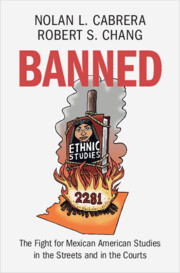Refine search
Actions for selected content:
77 results
13 - The Declaration in Anti-slavery and African American Thought
-
-
- Book:
- The Cambridge Companion to the Declaration of Independence
- Published online:
- 18 December 2025
- Print publication:
- 22 January 2026, pp 187-202
-
- Chapter
- Export citation
Chapter 2 - From “Superman” to Cannibal
- from Battling the Hydra of Profitable Hate in White Newspapers
-
- Book:
- The Harlem Renaissance Weekly
- Published online:
- 19 November 2025
- Print publication:
- 20 November 2025, pp 73-98
-
- Chapter
- Export citation
3 - Racial Citizenship Moments
- from Part I - Ghana–Soviet Entanglements
-
- Book:
- Socialist De-Colony
- Published online:
- 10 November 2025
- Print publication:
- 20 November 2025, pp 118-162
-
- Chapter
-
- You have access
- Open access
- HTML
- Export citation
1 - “Highlife Solidarity”
- from Part I - Ghana–Soviet Entanglements
-
- Book:
- Socialist De-Colony
- Published online:
- 10 November 2025
- Print publication:
- 20 November 2025, pp 29-79
-
- Chapter
-
- You have access
- Open access
- HTML
- Export citation
Against American Ethnic Democracy: White Rule and Black Rebellion
-
- Journal:
- Perspectives on Politics , First View
- Published online by Cambridge University Press:
- 07 August 2025, pp. 1-18
-
- Article
-
- You have access
- Open access
- HTML
- Export citation
7 - Finding the Leaks
-
- Book:
- Funding White Supremacy
- Published online:
- 27 May 2025
- Print publication:
- 12 June 2025, pp 148-173
-
- Chapter
- Export citation
1 - Recognizing the Wealth–Race Nexus
-
- Book:
- Funding White Supremacy
- Published online:
- 27 May 2025
- Print publication:
- 12 June 2025, pp 1-18
-
- Chapter
- Export citation
6 - Exploring Past Roots
-
- Book:
- Funding White Supremacy
- Published online:
- 27 May 2025
- Print publication:
- 12 June 2025, pp 120-147
-
- Chapter
- Export citation
4 - The American Civil War and Its Aftermath
-
- Book:
- Leaving the Fight
- Published online:
- 01 March 2025
- Print publication:
- 06 February 2025, pp 105-142
-
- Chapter
- Export citation
14 - Victory and National Renaissance Amidst Backlash
-
- Book:
- Banned
- Published online:
- 19 December 2024
- Print publication:
- 02 January 2025, pp 228-244
-
- Chapter
- Export citation

Banned
- The Fight for Mexican American Studies in the Streets and in the Courts
-
- Published online:
- 19 December 2024
- Print publication:
- 02 January 2025
Music gonna teach: Decolonising IR through a musical exploration of knowledge
-
- Journal:
- Review of International Studies / Volume 51 / Issue 1 / January 2025
- Published online by Cambridge University Press:
- 05 November 2024, pp. 121-138
- Print publication:
- January 2025
-
- Article
- Export citation
“If your ox does not pull, what are you going to do?”: Persistent Violence in South Africa’s Deep-Level Gold Mines and Its Contribution to the 1922 Rand Rebellion
-
- Journal:
- Comparative Studies in Society and History / Volume 66 / Issue 4 / October 2024
- Published online by Cambridge University Press:
- 14 August 2024, pp. 960-984
-
- Article
-
- You have access
- Open access
- HTML
- Export citation
4 - Seeking the Self in the Extreme
- from Part I - The Link between Exclusion and Extremism
-
-
- Book:
- Exclusion and Extremism
- Published online:
- 16 May 2024
- Print publication:
- 23 May 2024, pp 74-96
-
- Chapter
- Export citation
Chapter 4 - America and/as White Supremacy
-
-
- Book:
- The Cambridge Companion to American Utopian Literature and Culture since 1945
- Published online:
- 09 May 2024
- Print publication:
- 16 May 2024, pp 82-99
-
- Chapter
- Export citation
Africans in China, Western/White Supremacy and the Ambivalence of Chinese Racial Identity
-
- Journal:
- The China Quarterly / Volume 260 / December 2024
- Published online by Cambridge University Press:
- 15 March 2024, pp. 932-947
- Print publication:
- December 2024
-
- Article
-
- You have access
- Open access
- HTML
- Export citation
3 - Changemaking in Non-Black School Spaces
-
-
- Book:
- Young Black Changemakers and the Road to Racial Justice
- Published online:
- 08 February 2024
- Print publication:
- 15 February 2024, pp 33-59
-
- Chapter
- Export citation
9 - Sector Theorists Should Be Inclusive of Muslim and Non-Western Perspectives
- from Part II - Reflections and Refinements
-
-
- Book:
- Reimagining Nonprofits
- Published online:
- 11 January 2024
- Print publication:
- 01 February 2024, pp 174-190
-
- Chapter
- Export citation
10 - Words and Ropes: The Postwar Battles over Racial Order
- from Part III - Modern Traditions
-
- Book:
- Born in Blood
- Published online:
- 18 January 2024
- Print publication:
- 18 January 2024, pp 242-265
-
- Chapter
- Export citation
Race and systemic crises in international politics: An agenda for pluralistic scholarship
-
- Journal:
- Review of International Studies / Volume 50 / Issue 3 / May 2024
- Published online by Cambridge University Press:
- 11 January 2024, pp. 457-475
- Print publication:
- May 2024
-
- Article
-
- You have access
- Open access
- HTML
- Export citation
